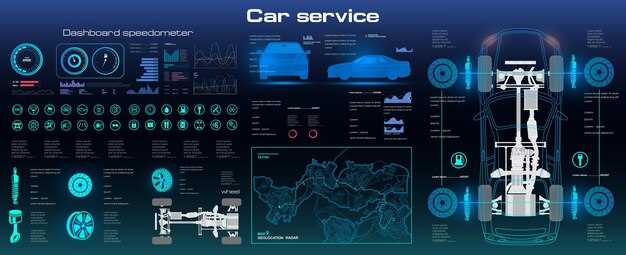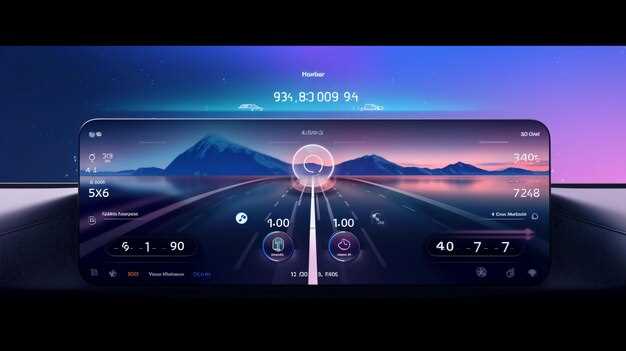Audi Head-Up Display – Benefits and Drawbacks

The integration of technology in vehicles has revolutionized the way we interact with our surroundings while driving. One of the most notable advancements in this area is the Head-Up Display (HUD) system utilized by Audi. This innovative display projects critical information directly onto the windshield, allowing drivers to maintain their focus on the road ahead. However, while the HUD provides several advantages, it also comes with certain drawbacks that warrant a thorough analysis.
Incorporating a display that presents information such as speed, navigation directions, and vehicle alerts in the driver’s line of sight can enhance situational awareness and reduce distraction. Audi’s HUD technology aims to create a seamless interface between the vehicle’s systems and the driver, promoting a safer and more enjoyable driving experience. Yet, despite these benefits, there are challenges associated with the functionality and usability of the HUD that users must consider.
This article delves into the specifics of the Audi HUD, examining its benefits, such as improved safety and convenience, alongside its potential drawbacks, including information overload and visibility issues. Understanding these factors is essential for drivers looking to maximize their vehicle’s capabilities while ensuring optimal safety on the road.
Understanding Audi HUD Technology: Key Features
Audi’s Head-Up Display (HUD) technology represents a significant advancement in automotive displays, enhancing the driving experience by seamlessly integrating vital information into the driver’s line of sight. This innovative tech projects essential data onto the windshield, allowing drivers to access information without diverting their attention from the road.
One of the key features of Audi HUD is its customizable display. Drivers can choose which data to project, including speed, navigation directions, and traffic signs, making the information highly relevant and personalized. This function allows users to tailor their driving experience according to their preferences and needs.
Another notable aspect of Audi HUD technology is its clarity and brightness. The system utilizes advanced optics and high-resolution graphics, ensuring that the displayed information remains visible in various lighting conditions, from bright sunlight to nighttime driving. This clarity is essential for maintaining safety and awareness on the road.
Moreover, Audi’s HUD tech incorporates augmented reality elements. It can overlay navigation information directly onto the road, providing spatial context that enhances situational awareness. This feature helps drivers comprehend directions in real time, reducing cognitive load and improving decision-making while driving.
In addition to navigation and speed, Audi HUD can display information about driver assistance systems. Alerts related to adaptive cruise control, lane departure warnings, and collision detection can be displayed, ensuring that drivers remain informed about their vehicle’s performance and safety features, thereby reducing the likelihood of accidents.
Lastly, Audi’s HUD technology is designed with user-friendly controls. Drivers can adjust settings easily through the vehicle’s infotainment system or steering wheel controls, allowing for a seamless integration of tech into everyday driving without distracting the driver from the road ahead.
Advantages of Audi Head-Up Display in Daily Driving

The Audi Head-Up Display (HUD) offers a range of benefits that enhance the driving experience on a daily basis. This advanced tech integrates crucial information directly into the driver’s line of sight, minimizing distraction and maximizing convenience.
-
Enhanced Safety:
The HUD reduces the need to glance away from the road. By displaying key information such as speed, navigation, and alerts directly in the driver’s view, it significantly enhances situational awareness and reduces the risk of accidents.
-
Improved Navigation:
With navigation prompts shown on the display, drivers can easily follow directions without deviating their focus from the road. This feature is particularly beneficial in unfamiliar territory, ensuring smoother and more stress-free travel.
-
Real-Time Information:
The tech provides real-time updates on important metrics, including fuel efficiency and speed. Drivers can make informed decisions based on this data, optimizing their driving habits.
-
Customization:
The Audi HUD can often be personalized to suit individual preferences. Drivers can choose which information to display, ensuring that they have access to the most relevant data for their journey.
-
Sleek Design:
The visual appeal of the HUD adds a modern touch to the driving experience. The display is designed to be unobtrusive yet informative, enhancing the overall aesthetic of the vehicle’s interior.
In summary, the Audi Head-Up Display technology enhances daily driving by increasing safety, improving navigation, providing real-time data, allowing for customization, and offering a stylish interface. This blend of functionality and convenience makes it a significant asset for any driver.
Potential Distractions: Assessing HUD Drawbacks

While the Audi Head-Up Display (HUD) offers numerous advantages, it also presents potential distractions that can detract from the driving experience. One significant concern is the visual clutter created by multiple information layers on the display. When excessive data is presented simultaneously, drivers may struggle to focus on the most critical information, leading to cognitive overload.
Another drawback is the positioning of the HUD itself. Although designed to keep essential information within the driver’s line of sight, misalignment or glare from sunlight can obscure crucial data. This issue can cause frustration and could impact reaction times, especially in high-speed scenarios where quick decision-making is vital.
Additionally, the reliance on HUD technology might foster a false sense of security. Drivers may become overly dependent on the display, neglecting traditional means of information gathering, such as checking mirrors or using peripheral vision. This over-reliance can lead to delayed reactions in unexpected situations, increasing the risk of accidents.
Moreover, HUD interfaces often include interactive elements, such as navigation prompts and notifications. While these features enhance functionality, they can also divert a driver’s attention away from the road. The temptation to engage with these interactive displays may result in momentary lapses in concentration, which can have serious consequences.
In summary, while the Audi HUD system introduces innovative features that enhance convenience and safety, it is crucial to recognize the potential distractions it may cause. Balancing the benefits of the display with an awareness of its drawbacks is essential for maintaining safe driving practices.
Comparison of Audi HUD with Traditional Dashboards
The Audi Head-Up Display (HUD) represents a significant advancement in automotive technology, providing critical information directly on the windshield. This innovative display allows drivers to maintain focus on the road while accessing essential data, such as speed, navigation directions, and alerts, without shifting their gaze away from their driving path.
In contrast, traditional dashboards present information in a more conventional manner, often requiring drivers to take their eyes off the road to monitor gauges and indicators. While these dashboards have been reliable for decades, they can lead to distractions, especially in high-speed situations. The separation of visual information from the driving experience creates potential safety risks.
One of the prominent benefits of the Audi HUD is its ability to overlay important data onto the real-world view, enhancing situational awareness. This integration aims to minimize the cognitive load on the driver, making it easier to process information quickly. Traditional dashboards, while straightforward, can overload drivers with data, leading to moments of confusion or delayed reactions.
Additionally, the HUD offers customizable displays that can be tailored to the preferences of the driver, presenting data in a format that is most useful at any given moment. Traditional dashboards, however, have fixed layouts and designs that may not cater to individual needs or preferences, potentially limiting effectiveness during varied driving conditions.
However, the Audi HUD is not without its drawbacks. The reliance on technology raises concerns about potential malfunctions or visibility issues in certain lighting conditions, such as bright sunlight or at night. Furthermore, the additional complexity of managing HUD features may pose a learning curve for some drivers, who may find traditional dashboards more intuitive.
In summary, the comparison of the Audi Head-Up Display with traditional dashboards reveals a shift towards a more interactive and integrated driving experience. While the HUD improves accessibility and information processing, traditional dashboards maintain simplicity and reliability. Ultimately, the choice between the two may depend on individual preferences and driving styles.
User Experience: Real-World Feedback on Audi HUD
The Audi Head-Up Display (HUD) has garnered significant attention in the automotive tech landscape, offering a futuristic approach to driver information. Users frequently commend its ability to project essential data onto the windshield, allowing for a seamless integration of information without requiring drivers to divert their gaze from the road.
A prominent benefit cited by users is the clarity of the display. The HUD provides a crisp, vibrant image that effectively highlights important metrics such as speed, navigation directions, and adaptive cruise control settings. This feature enhances situational awareness and minimizes distractions, contributing to overall safety while driving.
However, feedback also reveals some drawbacks. Some drivers have reported issues with visibility in bright daylight, where the display can become less legible. Additionally, the positioning of the HUD may not suit everyone; individuals of varying heights might find it challenging to view the projected information comfortably. This inconsistency can lead to a less optimal user experience, detracting from the technology’s intended benefits.
Another aspect of user feedback pertains to customization options. Audi has implemented a range of settings allowing users to tailor how information is displayed, which many appreciate. This feature empowers drivers to prioritize the information they deem most crucial, thereby enhancing the personal connection to the vehicle’s tech.
In summary, the real-world feedback on the Audi HUD highlights its innovative approach to automotive tech, lauding its clarity and safety features. However, challenges with visibility and user preference demonstrate that further refinements may be necessary to achieve a universally optimal experience.
Future Developments in HUD Technology: What to Expect
As technology advances, the future of Head-Up Display (HUD) systems is poised for significant improvements, enhancing user experience and safety. One anticipated development is the integration of augmented reality (AR) into HUD display systems. By overlaying virtual data onto real-world views, HUDs could provide drivers with critical information such as navigation prompts, hazard alerts, and environmental conditions directly in their line of sight.
Another exciting advancement is the incorporation of artificial intelligence (AI) to personalize HUD functionalities. AI could analyze driving habits and preferences, adjusting the display dynamically to show the most relevant information at any given moment. This level of customization could greatly improve situational awareness and reduce distraction.
Furthermore, the evolution of display technologies, such as OLED and microLED, promises sharper images and better visibility in various lighting conditions. Future HUDs are expected to feature brighter, more vibrant displays that enhance readability while minimizing strain on the eyes.
Connectivity is also set to revolutionize HUD technology. With advancements in vehicle-to-everything (V2X) communication, HUDs could receive real-time updates on traffic conditions, weather forecasts, and even vehicle mechanics, creating a more informed and safer driving experience.
Lastly, developments in head-tracking technology could allow HUDs to adapt the information displayed based on the driver’s gaze, ensuring essential information is always in focus while reducing information overload. This capability would mark a significant leap in user interaction with HUD systems, making them not only more intuitive but also safer.




